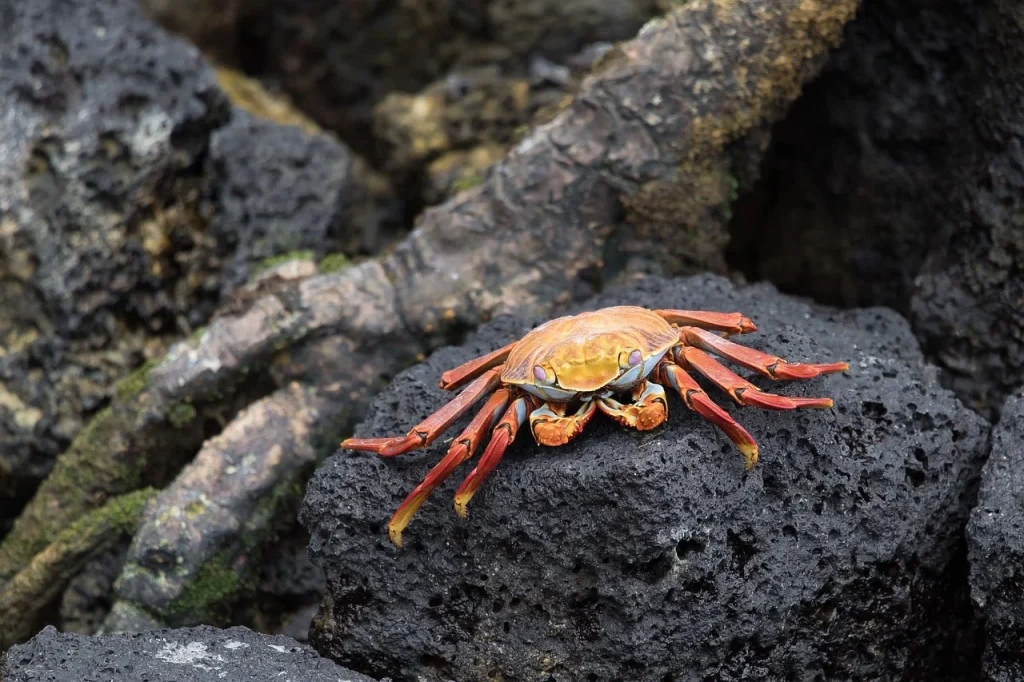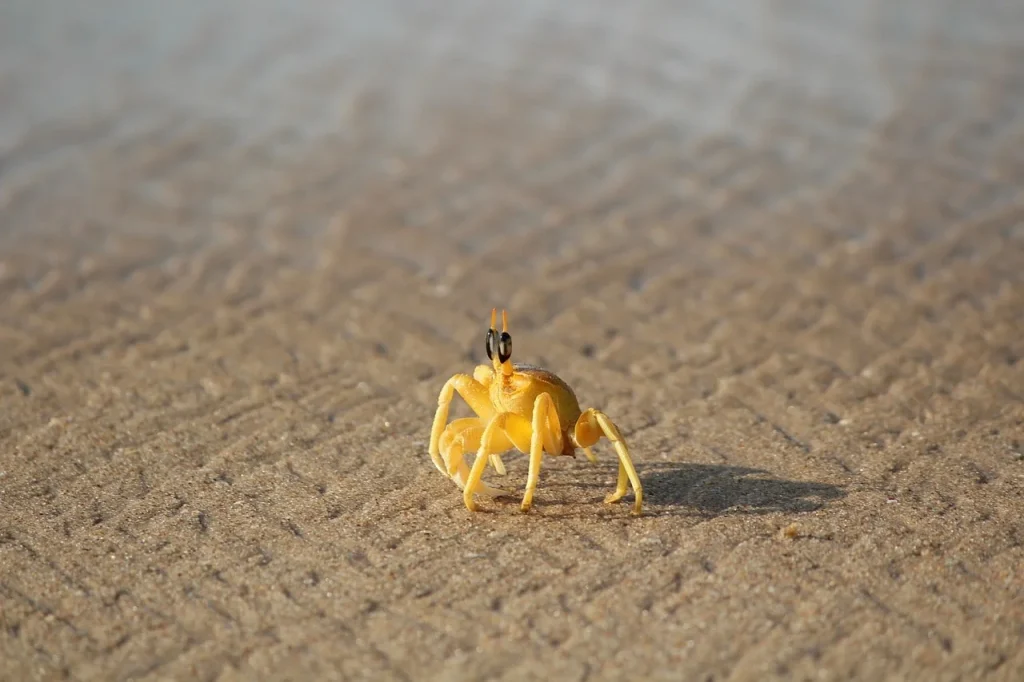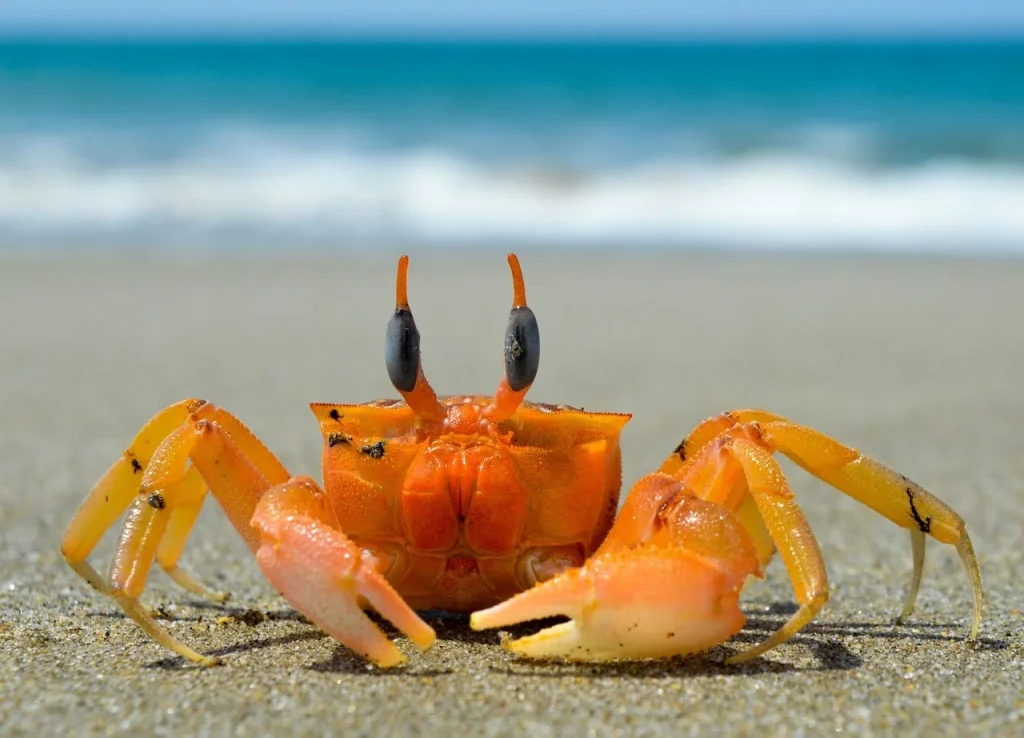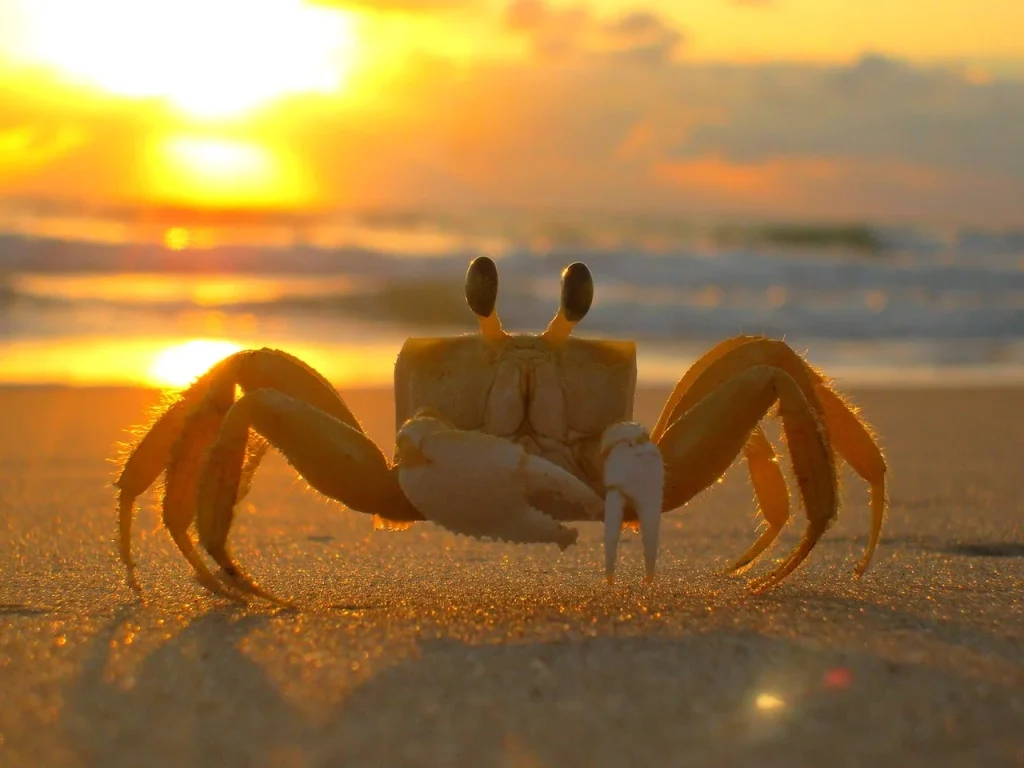Crabs might just be the ocean’s most charismatic inhabitants. With their distinctive walk and impressive claws, they seem to be nature’s engineers, constantly at work or on the defense.
In today’s blog, we’ll uncover some cool facts about these marvelous creatures. Did you know that crabs have a way of communicating that would put some secret agents to shame? Yes, even James Bond could learn a trick or two from them!
The crab that walks too far falls into the pot.
Haitian Proverb
Crab Facts
Get ready to explore the fascinating world of crabs! Read on to uncover facts that will prepare you for the quiz waiting at the bottom of this article.
- Coconut crabs can climb trees and have a pinching force strong enough to break a coconut.
- The pea crab is one of the smallest species, living inside oyster shells or other bivalves as a parasite.
- Some species can produce sounds by rubbing their claws or body parts together, a behavior used for communication and threat displays.
- Crabs taste with their feet, which have chemoreceptors to detect chemicals in the water, helping them find food.
- Christmas Island sees millions of red crabs migrate from the forest to the sea to lay their eggs, coloring the landscape crimson.
- Crabs have complex mating rituals and dances to attract partners and deter rivals.
- The lifespan of some species can be over 30 years, with individuals growing continuously through a process called molting.
- Fiddler crabs are famous for their asymmetric claws; the males have one very large claw used for communication and fights.
- Crabs are omnivores, often scavenging dead animals but also hunting smaller creatures and consuming plant material.
- The Yeti crab, discovered in 2005, hosts bacteria on its hairy claws, which detoxify poisonous minerals from the water.
- Sally Lightfoot crabs are remarkably agile, able to leap across rocks and dodge waves with ease.
- A crab’s blood is blue due to the presence of copper-based hemocyanin, which is used for oxygen transport.
- Some species practice serial monogamy, staying with one mate for a season before moving on to another the next year.

- Deep-sea crabs have developed the ability to live at crushing depths where light never penetrates.
- Hermit crabs, unlike true crabs, have soft abdomens and use the shells of other mollusks for protection.
- Decorator crabs adorn themselves with materials from their environment for camouflage against predators.
- The largest crab on record is the Japanese spider crab, with a leg span up to 3.8 meters (12.5 feet) and weighing up to 19 kilograms (42 lbs).
- Mangrove crabs contribute significantly to the ecosystem by processing vegetation and enhancing nutrient recycling.
- Puget Sound king crabs can fluoresce, emitting light to confuse predators or attract mates.
- Horseshoe crabs are not true crabs but are related to arachnids (spiders and scorpions).
- Some species can regenerate lost limbs, a process that can take several molting cycles to complete.
- The arrow crab’s legs can be three times the length of its body, helping it navigate through complex coral structures.
- Crabs communicate through a variety of means, including visual signals, physical movements, and even producing sounds.
- Alaskan king crabs are among the most commercially valuable species, supporting a large and iconic fishing industry.
- Giant land crabs carve out burrows that can be up to 1.5 meters deep to provide a cool environment and protection from predators.
- Box crabs use their claws to dig into the sand and bury themselves as a method of ambush hunting.
- Swimming crabs have flattened rear legs adapted as flippers, making them adept at moving through water.
- The sponge crab wears a live sponge on its back as camouflage and protection from predators.

- Some species have a very specialized diet; for example, the porcelain crab filters plankton from the water with its mouthparts.
- Gecarcinus quadratus, a type of land crab, migrates in massive groups during breeding seasons, creating spectacular natural phenomena.
- The pincer size of a crab can indicate its health and vitality, which is often used by potential mates in their selection process.
- Crabs play an important role in folklore and mythology in various cultures, symbolizing protection and renewal.
- Portunus trituberculatus is the most heavily fished species worldwide, particularly sought after in Asian markets.
- Crabs have been found at all ocean depths, from shallow tide pools to the Mariana Trench, the deepest point in the world’s oceans.
- Ghost crabs have the ability to change color to match their environment, enhancing their camouflage capabilities.
- The unique motion of crabs, generally sideways, is due to the structure of their legs, which provides more stability and speed along the ocean floor.
- Climate change and rising sea temperatures are impacting crab populations, altering habitats, and affecting reproductive cycles.
- Threats to various species include habitat destruction, pollution, and overfishing, which disrupt ecological balance.

- Stone crabs are harvested for their claws, which are considered a delicacy; interestingly, the crabs can survive the removal and regenerate these limbs.
- During mating, the male crab often carries the female for several days until she molts and is ready to mate, ensuring that he can fertilize her eggs immediately.
- The carry crabs can attach sea urchins, anemones, and other stinging creatures to their shells for defense.
- Bioluminescent bacteria can live on certain crabs, causing them to glow eerily in the dark ocean waters.
- The Dungeness crab is highly prized for its sweet meat and is a staple in Pacific Northwest cuisine.
- Crab fishing is one of the most dangerous professions, as highlighted by the popular television series “Deadliest Catch.”
- Research indicates crabs can feel pain, leading to debates on ethical practices in handling and cooking them.
- The social structure of crab populations can be complex, with hierarchies that affect feeding, mating, and defense behaviors.
- Conservation efforts for endangered species include creating protected areas, restocking programs, and regulations on fishing practices.
- Crabs use a variety of habitats, from sandy beaches to rocky shores and even trees, adapting uniquely to each environment.
- The molting process is critical for growth; during this vulnerable time, crabs must hide from predators as their new shell hardens.
- Temperature plays a crucial role in determining the timing of molting and reproduction, with warmer waters often accelerating these processes.
Crab Myths

Now that we’ve covered the facts, let’s clear up some common misconceptions. In the next section, we’ll separate the truth from the myths surrounding crabs.
- Crabs are always red
It is commonly believed that they are red, but this coloration mainly occurs when they are cooked. In their natural habitat, crabs are found in a variety of colors, including brown, blue, and green, which helps them blend into their environments. - Crabs only live in saltwater
While many species are marine-based, several crab species thrive in freshwater and even on land. The diversity in their habitats is remarkable, ranging from deep sea vents to tropical forests. - Crabs have ten legs
This is a misconception that often arises because crabs are decapods. However, they possess eight walking legs and two claws, which are often mistaken for legs but are primarily used for feeding and defense. - All crabs walk sideways
Sideways locomotion is observed in many crabs due to the structure of their legs. However, some species can move forwards or backwards as well. The direction of movement is chosen based on the situation and the specific species’ capabilities. - Crabs are aggressive and dangerous
They are generally not aggressive; their behavior is mostly defensive. They might use their claws if threatened, but they mostly prefer to hide or retreat. Their fearsome reputation is largely exaggerated beyond the reality of their nature.
No products found.
Crab Quotes

Let’s explore some quotes about the lives and symbolism of crabs. Feel free to share yours in the comments so I can add them to the list as well.
A crab does not beget a bird.
John Heywood
John Heywood, an English playwright, employs this phrase to emphasize that offspring typically resemble their parents, both in nature and in character.
The movements of the crab are proper to the crab.
Theognis of Megara
This quote from Theognis, a Greek lyric poet, suggests that all creatures, including humans, have characteristics and behaviors unique to their nature.
He is a fool who lets slip a bird in the hand for a bird in the bush, or a crab in the water.
Plutarch
Plutarch, a Greek biographer, uses this metaphor to highlight the folly of giving up a certain advantage for a potential one that might prove elusive.
The house of the loud talker leaks.
African Proverb
This African proverb, often associated with cautionary tales about crabs, serves as a warning that those who boast or speak too much may inadvertently expose their weaknesses or secrets.
Like a crab, don’t walk too straightforward, but always go a little sideways.
Mehmet Murat ildan
Mehmet Murat ildan, a contemporary Turkish playwright and novelist, uses the crab’s unique gait as a metaphor for approaching life’s challenges with caution and strategy rather than head-on confrontation.
Crab FAQ

Next up: the FAQ section. This is your last stop before the quiz, so make sure to review these questions carefully to prepare fully.
- What crabs are not edible?
Not all crabs are good for eating. Some species, like the horseshoe crab, aren’t typically consumed because they’re more related to spiders than to true crabs, and their body composition is different. Also, certain crabs may inhabit polluted areas, making them unsafe to eat due to toxins. - Can crabs swim?
Yes, some of them can swim! Species like the blue crab have specially adapted hind legs shaped like paddles, which allow them to swim. However, most crabs are more adept at walking along the bottom of their habitat rather than swimming. - Are crabs fish?
No, they are not fish. They are crustaceans, which means they have a hard external shell (exoskeleton), two pairs of antennae, and bodies divided into segments. Fish, on the other hand, are vertebrates that breathe through gills and generally have scales and fins. - How do crabs reproduce?
They reproduce sexually. The male crab deposits sperm into the female, who then fertilizes her eggs and carries them under her abdomen until they hatch. This method varies slightly among different species, but the general process is quite similar across most crab species. - Can crabs feel pain?
This is a subject of ongoing research, but there is evidence to suggest that they can indeed feel pain. Studies have shown that crabs react to harmful stimuli in ways that suggest a pain response, such as changing their behavior to avoid future discomfort.
No products found.
Crab Trivia

Welcome to the ultimate crab quiz! Get ready to claw your way through some shell-shocking questions. Beware; if you don’t get any right, you might just find yourself in a pinch!
Crab Merch
If you are a true fan of crabs, then you definitely need to check out our merchandise. You can find T-shirts, hoodies, mugs, and tote bags for your favorite designs. Feel free to check out all the other designs in our shop.
Conclusion
Finally, the world of crabs offers us a window into the complexity and beauty of marine ecosystems. These creatures are not only essential to the ecological balance but also demonstrate the adaptability required to survive under the sea.
Their diversity in form and function is a reminder of nature’s creativity. So, let’s give it up for crabs, the unsung heroes of the ocean! Till next time, stay curious and explore more. Cheers.


